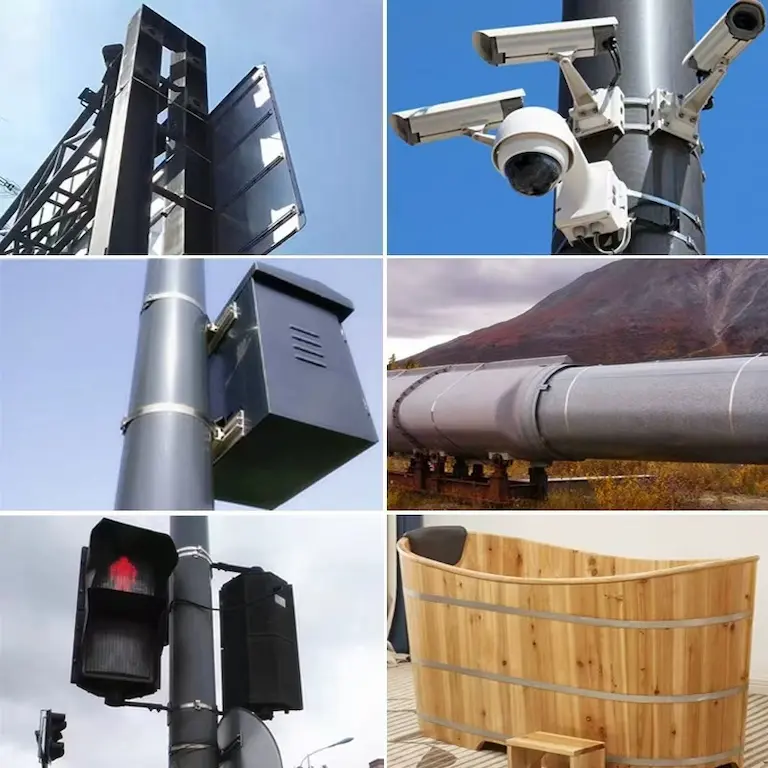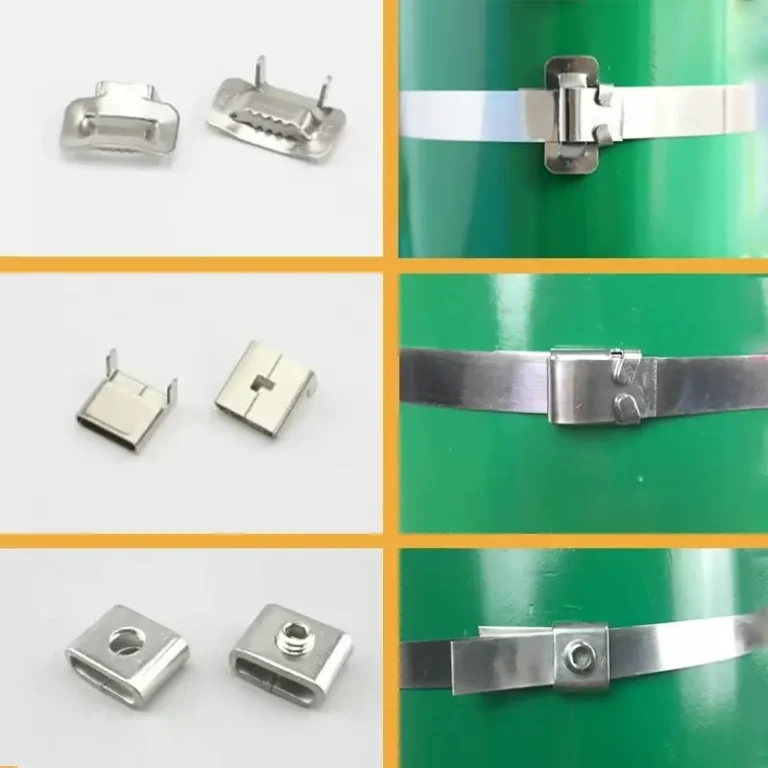Stainless Steel Belt: Characteristics, Advantages, and Applications
The characteristics of stainless steel belts are wear resistance, long-lasting quality and corrosion resistance. Stainless steel belts are extensively employed in the production of chemicals, food, rubber, plastics, wood and laminate. Although stainless steel belts are great for radiant heating use, they can be utilized for applications where radiant heating is required but ringing temperatures are exceeded on steel belts. In their construction, carbon steel or stainless steel are often used.
Carbon steel belts disperse heat more evenly because most stainless steel alloys are poor heat conductors. Food processing, transportation, and bake ovens all use carbon steel belts. A relatively common belt material is steel with a soft or silky finish. Choosing fine texture steel because of its non-stick characteristics is one of the key reasons for using it. In the laminate sector, this seems to be a great approach.
Stainless Steel Belt
All-Stainless Steel Waist Belts
How Do the Advantages of Using Stainless Steel Belts Differ from Those of Other Materials?
Applications that make use of Stainless Steel Belts
How Can I Get The Perfect Material?Stainless Steel Belt
Advanced timed pulles to assure accurate, cyclical product movements are employed in designing stainless steel belts. Conveyor belt perforations are used to guarantee the pulley inlet’s timing of the teeth is timed on to the pulley outlet. In addition, attachment points are provided for timing on the outer circle of the pole. Whichever program you look at, the time is solely used for timing and movement creation is not. The belt continues to move, even with the frictional forces between the ribbons and pulleys.
Another advantage of stainless steel belts is their versatility, which enables them to be customized for timing, positioning, and indexing. Both belts, on the other hand, offer the same level of durability, including resistance to impact, high temperatures, harsh chemicals, and high vacuums.
Characteristics
Loops made of soil stainless steel are the rounded surface edges of ground stainless steel loops with surface ruggednesses between 0,04 and 0,01 Ra. Either level, straightened steel belts or straight configurations that guarantee the flatness and straightening of the belt are precisely available. The ends are ground and prepped for welding on-site in an open length; the strip has a sold junction in an unending condition.
Decorative and Perforated Stainless Steel Belts
Steel straps with holes allow the passage of drying media, such as hot air, to put all product parts on the belt into touch with the air. Perforated belts are almost always available from all manufacturers and may be fitted to most applications in a wide range of perforated patterns. Several alternative designs with 0.8 mm (0.03in) hole diameter and ranges from 0.02 to 0.05 mm (0.0008 to 0.002in.) are possible for unique applications.
Try for free AISI 4140 Low Alloy Steel
You can get the more cost-effective 200-series , 300-series and 400-series stainless steel material from Yaoyi. Thickness 0.1 mm~0.3 mm, width 550-600 mm cold rolled stainless steel coil are provided.
All-Stainless Steel Waist Belts
Belt in stainless steel with ultra mirror surface for thin film and ceramic sheeting production Thicknesses of these belts range from 0.60 mm to 2.00 mm with maximum variations of 80 meters (0.02362 to 0.0787 in.) The loops made of polished steel with an open length can be produced in an endless number of lengths or can be turned into straps.
Superior quality plastic foils and films, such as optical films and film for packaging, are produced with smooth and consistent stainless steel belts. The thickness is normally 0.03 to 0.60 mm (0.012 to 0.23 inch). Seamless steel belts are useful for machines with small drum sizes requiring broad belts.
Ordered as standard in cold-rolled stainless steel, these solid belts have Ra 0.4 mill finish and well-rounded edges. Hard carbon steel belts come in two distinct varieties: with mill finish Ra 0.4 and well-rounded edges as standard, and without mill finish Ra 0.4 and with a well-rounded edge. Level and straight steel belts are delivered in open lengths, and the ends are ready for on-site welding.
Try for free AISI 4140 Low Alloy Steel
Single and double belts in stainless steel
Single rim systems employ steel rims, whilst double rims use steel and nylon rims. rims. Goods such as pads, pads, bands and sheets are usually conveyed on one side of a product exclusively by single stainless steel conveyor belts. The Double Belt System allows the top and bottom of a product to be processed simultaneously. The advantages of a double conveying system for the treatment of chemical, rubber, laminate or composite materials are numerous.
Nickel-Plated Stainless Steel Belts: Technical Data
The term “repeatability” refers to a pitch’s ability to return to its original position (within a specified tolerance) following multiple belt revolutions. Pulleys move faster than belts in conventional friction drive systems. If this is not addressed, pitch accumulation and belt creep can occur.
Stainless steel belts are non-stretchable, which means they can frequently meet repeatability specifications of 0.002″ (0.051 mm) to 0.005″ (0.127 mm) (0.127 mm). When timing belts and timing pulleys are used in conjunction, the effect of belt creep is further reduced, making stainless steel the best option for maintaining precision in critical applications.
Flat belt made of stainless steel
In both cases, the material is a type of carbon or stainless steel with characteristics such as ductility, strength, and heat conductivity that has been alloyed or treated specifically for the application.
The width of the belt can therefore range from 400 to 3000 mm, while the thickness may be from 0.6 to 3.0 mm. In particular applications, loops that are smaller, thinner or broader and thicker may be required. However, these are exceptions instead than the rule. Although most applications need bands between 10 and 100 meters in length, theoretically, a belt of indefinite length can be designed through the connection of several short bands.
Get it now:A complete guide to AISI 410 Stainless Steel
How Do the Advantages of Using SS Belts Differ from Those of Other Materials?
The cost
Indestructibility
Troubleshooting and upkeep
Repair work is fairly straightforward
Try for free information about the A Complete Guide to AISI 321 Stainless Steel
Applications that Make Use of SS Belts
The food manufacturing industry
Food industry steel belts are hygienic, simple to clean, dependable, and easily customizable. One usage for them is for meat and vegetable drying, freeze drying instant coffee, and making chocolate droplets.
Additionally, the food processing industry makes use of conveyor automation with novel and variable handling methods; their conveyor systems are customized to meet the requirements of various edible goods. Stainless steel metal conveyor belts are ideal for cooking, freezing, and handling edible products ranging from meat and seafood to frozen pizzas and ice cream. They have demonstrated the ability to shift and sustain while remaining simple to assemble in almost any food processing system, which is especially important if you are looking for superior results.
Antioxidant Preservation
A flavor is an essential predictor of a food’s overall quality. Due to the fact that different gases (so-called outgas) that may harm the quality of the items handled by plastic and rubber transporting belts are released, these should not be employed. The taste and quality of food cannot be contaminated with metal conveyor belts which do not exhaust or require lubricating. Since the steel belt does not tear or create particles that could threaten customers, it is perfect for conveyor belt applications.
This implies that since stainless steel belts offer a nonporous, flat surface that won’t absorb microorganisms, they will be ideal for keeping surfaces clean. In comparison to plastic belts, they are resistant to chips, scratches, and pits that can serve as places of contamination like plastic belts. Make sure you select the appropriate cleaning method for your product or business; using chemical sprays, hot pressure washing, or steam pressure, you can sterilize stainless steel belts.
Read more:A complete guide to AISI 304L Stainless Steel
Chemo
For production procedures, this industry uses continuous stainless steel belts. In this industry, steel straps are utilized for transferring heat and/or pressure, not conveyor straps. Casting, polymerizing resins, para-fins and waxes are only a few of the many applications in the chemical industry for steel bands.
Automobiles and Trains
Steel belts help to carry items or raw materials such as wood efficiently. Steel strap is utilized in a wide range of industries, such as industrial package sorting, bulk distribution, maintenance of equipment and many more applications. Clear tracking, exceptional abrasion resistance and dynamic fatigue resistance are crucial for hauling large objects or unit loads. The quicker you run, the higher the stresses and operational conditions. This rigid standard is manufactured to satisfy steel belts.
Wood Processing
Steel loops are key ingredients of current, ongoing production processes for WBPs like particle panels, OSB- and MDF boards, since they are used as heat and pressure transmission media for a dual function. This application substantially affects the surface quality of the finished panel by the surface of the steel belt which requires rigorous consideration for uniformity of widths and finishing of steel belt surfaces.
Keep reading: A complete guide to AISI 303 Stainless Steel
How Can I Get The Perfect Material?
For a long time in the past, the purchasing specialists of stainless steel belt manufacturers always struggled to find good raw materials and stable suppliers.
As a manufacturer with more than 25 years of experience, we have accumulated rich experience and a large number of important customers in the field of stainless steel strip production. Our stainless steel belt products have successfully helped our customers produce products that are widely welcomed by the market in accordance with their requirements, and have won huge profits.
In view of this, trying to cooperate with us will be one of the most correct choices you will make this year. If you want to get free samples, please leave your requirements and email now, we will get in touch with you as soon as possible.
Get it now:AISI 302 Stainless Steel
Stainless Steel Belt: Characteristics, Advantages, and Applications

Ewan Liao
The characteristics of stainless steel belts are wear resistance, long-lasting quality and corrosion resistance. Stainless steel belts are extensively employed in the production of chemicals, food, rubber, plastics, wood and laminate. Although stainless steel belts are great for radiant heating use, they can be utilized for applications where radiant heating is required but ringing temperatures are exceeded on steel belts. In their construction, carbon steel or stainless steel are often used.
Carbon steel belts disperse heat more evenly because most stainless steel alloys are poor heat conductors. Food processing, transportation, and bake ovens all use carbon steel belts. A relatively common belt material is steel with a soft or silky finish. Choosing fine texture steel because of its non-stick characteristics is one of the key reasons for using it. In the laminate sector, this seems to be a great approach.
Material Testing After You Place An Stainless Steel Foil Order
Hardness Testing
Ingredient detection
Tensile Strength Test
Table of Contents
Stainless Steel Belt
Advanced timed pulles to assure accurate, cyclical product movements are employed in designing stainless steel belts. Conveyor belt perforations are used to guarantee the pulley inlet’s timing of the teeth is timed on to the pulley outlet. In addition, attachment points are provided for timing on the outer circle of the pole. Whichever program you look at, the time is solely used for timing and movement creation is not. The belt continues to move, even with the frictional forces between the ribbons and pulleys.
Another advantage of stainless steel belts is their versatility, which enables them to be customized for timing, positioning, and indexing. Both belts, on the other hand, offer the same level of durability, including resistance to impact, high temperatures, harsh chemicals, and high vacuums.
Characteristics
Loops made of soil stainless steel are the rounded surface edges of ground stainless steel loops with surface ruggednesses between 0,04 and 0,01 Ra. Either level, straightened steel belts or straight configurations that guarantee the flatness and straightening of the belt are precisely available. The ends are ground and prepped for welding on-site in an open length; the strip has a sold junction in an unending condition.
Decorative and Perforated Stainless Steel Belts
Steel straps with holes allow the passage of drying media, such as hot air, to put all product parts on the belt into touch with the air. Perforated belts are almost always available from all manufacturers and may be fitted to most applications in a wide range of perforated patterns. Several alternative designs with 0.8 mm (0.03in) hole diameter and ranges from 0.02 to 0.05 mm (0.0008 to 0.002in.) are possible for unique applications.
Try for free AISI 4140 Low Alloy Steel
You can get the more cost-effective 200-series , 300-series and 400-series stainless steel material from Yaoyi. Thickness 0.1 mm~0.3 mm, width 550-600 mm cold rolled stainless steel coil are provided.
All-Stainless Steel Waist Belts
Belt in stainless steel with ultra mirror surface for thin film and ceramic sheeting production Thicknesses of these belts range from 0.60 mm to 2.00 mm with maximum variations of 80 meters (0.02362 to 0.0787 in.) The loops made of polished steel with an open length can be produced in an endless number of lengths or can be turned into straps.
Superior quality plastic foils and films, such as optical films and film for packaging, are produced with smooth and consistent stainless steel belts. The thickness is normally 0.03 to 0.60 mm (0.012 to 0.23 inch). Seamless steel belts are useful for machines with small drum sizes requiring broad belts.
Ordered as standard in cold-rolled stainless steel, these solid belts have Ra 0.4 mill finish and well-rounded edges. Hard carbon steel belts come in two distinct varieties: with mill finish Ra 0.4 and well-rounded edges as standard, and without mill finish Ra 0.4 and with a well-rounded edge. Level and straight steel belts are delivered in open lengths, and the ends are ready for on-site welding.
Try for free AISI 4140 Low Alloy Steel
Single and double belts in stainless steel
Single rim systems employ steel rims, whilst double rims use steel and nylon rims. rims. Goods such as pads, pads, bands and sheets are usually conveyed on one side of a product exclusively by single stainless steel conveyor belts. The Double Belt System allows the top and bottom of a product to be processed simultaneously. The advantages of a double conveying system for the treatment of chemical, rubber, laminate or composite materials are numerous.
Nickel-Plated Stainless Steel Belts: Technical Data
The term “repeatability” refers to a pitch’s ability to return to its original position (within a specified tolerance) following multiple belt revolutions. Pulleys move faster than belts in conventional friction drive systems. If this is not addressed, pitch accumulation and belt creep can occur.
Stainless steel belts are non-stretchable, which means they can frequently meet repeatability specifications of 0.002″ (0.051 mm) to 0.005″ (0.127 mm) (0.127 mm). When timing belts and timing pulleys are used in conjunction, the effect of belt creep is further reduced, making stainless steel the best option for maintaining precision in critical applications.
Flat belt made of stainless steel

In both cases, the material is a type of carbon or stainless steel with characteristics such as ductility, strength, and heat conductivity that has been alloyed or treated specifically for the application.
The width of the belt can therefore range from 400 to 3000 mm, while the thickness may be from 0.6 to 3.0 mm. In particular applications, loops that are smaller, thinner or broader and thicker may be required. However, these are exceptions instead than the rule. Although most applications need bands between 10 and 100 meters in length, theoretically, a belt of indefinite length can be designed through the connection of several short bands.
Get it now:A complete guide to AISI 410 Stainless Steel
How Do the Advantages of Using SS Belts Differ from Those of Other Materials?
The cost
Instead, stainless steel belts are more expensive than employing alternate materials, such as plastic belt. However, it also has the advantage that oil is not made. Manufacture of steel belt costs less per linear foot than manufacturing of plastic belt. In addition, the production cost of the steel belt is lower than that of the plastic belt.
Indestructibility
Stainless steel belts are heat and cold as well as severe surroundings such as space and vacuum resistant. Many of these objects are meant to handle long-term loads, such as bending and cooling. An alloy consisting of numerous metals with different chemical characteristics, humidity and resistance to corrosion can be used. In general, engineers select a belt material based on its physical characteristics, cost and availability.
Troubleshooting and upkeep

This is often the case with conveyor systems for stainless steel belt. The steel conveyor system also addresses concerns like belt tracking and restocking of stocks.
Repair work is fairly straightforward
Most belts made of stainless steel will deform over time. Other methods of flattening a steel belt’s curvature are possible. A rapidly, on-site, and cost-effective shot peening process for smoothing out curved steel belts is known and widely used.
Try for free information about the A Complete Guide to AISI 321 Stainless Steel
Applications that Make Use of SS Belts
The food manufacturing industry
Food industry steel belts are hygienic, simple to clean, dependable, and easily customizable. One usage for them is for meat and vegetable drying, freeze drying instant coffee, and making chocolate droplets.
Additionally, the food processing industry makes use of conveyor automation with novel and variable handling methods; their conveyor systems are customized to meet the requirements of various edible goods. Stainless steel metal conveyor belts are ideal for cooking, freezing, and handling edible products ranging from meat and seafood to frozen pizzas and ice cream. They have demonstrated the ability to shift and sustain while remaining simple to assemble in almost any food processing system, which is especially important if you are looking for superior results.
Antioxidant Preservation
A flavor is an essential predictor of a food’s overall quality. Due to the fact that different gases (so-called outgas) that may harm the quality of the items handled by plastic and rubber transporting belts are released, these should not be employed. The taste and quality of food cannot be contaminated with metal conveyor belts which do not exhaust or require lubricating. Since the steel belt does not tear or create particles that could threaten customers, it is perfect for conveyor belt applications.
This implies that since stainless steel belts offer a nonporous, flat surface that won’t absorb microorganisms, they will be ideal for keeping surfaces clean. In comparison to plastic belts, they are resistant to chips, scratches, and pits that can serve as places of contamination like plastic belts. Make sure you select the appropriate cleaning method for your product or business; using chemical sprays, hot pressure washing, or steam pressure, you can sterilize stainless steel belts.
Chemo
For production procedures, this industry uses continuous stainless steel belts. In this industry, steel straps are utilized for transferring heat and/or pressure, not conveyor straps. Casting, polymerizing resins, para-fins and waxes are only a few of the many applications in the chemical industry for steel bands.
Automobiles and Trains
Steel belts help to carry items or raw materials such as wood efficiently. Steel strap is utilized in a wide range of industries, such as industrial package sorting, bulk distribution, maintenance of equipment and many more applications. Clear tracking, exceptional abrasion resistance and dynamic fatigue resistance are crucial for hauling large objects or unit loads. The quicker you run, the higher the stresses and operational conditions. This rigid standard is manufactured to satisfy steel belts.
Wood Processing
Steel loops are key ingredients of current, ongoing production processes for WBPs like particle panels, OSB- and MDF boards, since they are used as heat and pressure transmission media for a dual function. This application substantially affects the surface quality of the finished panel by the surface of the steel belt which requires rigorous consideration for uniformity of widths and finishing of steel belt surfaces.
Keep reading: A complete guide to AISI 303 Stainless Steel
How Can I Get The Perfect Material?
For a long time in the past, the purchasing specialists of stainless steel belt manufacturers always struggled to find good raw materials and stable suppliers.
As a manufacturer with more than 25 years of experience, we have accumulated rich experience and a large number of important customers in the field of stainless steel strip production. Our stainless steel belt products have successfully helped our customers produce products that are widely welcomed by the market in accordance with their requirements, and have won huge profits.
In view of this, trying to cooperate with us will be one of the most correct choices you will make this year. If you want to get free samples, please leave your requirements and email now, we will get in touch with you as soon as possible.
Get it now:AISI 302 Stainless Steel
